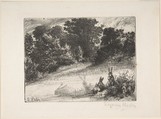Combe Bottom
Sir Francis Seymour Haden British
Not on view
Seymour Haden was the unlikely combination of a surgeon and an etcher. Although he pursued a very successful medical career, he is mostly remembered for his etched work as well as for his writings on etching. He was one of a group of artists, including James McNeill Whistler (1834–1903) and Alphonse Legros (1837–1911), whose passionate interest in the medium led to the so-called etching revival, a period that lasted well into the twentieth century. The extolling of etching for its inherent spontaneous qualities reached its pinnacle during this time. While the line of the etching needle, Haden wrote, was "free, expressive, full of vivacity," that of the burin was "cold, constrained, uninteresting," and "without identity."
Landscape with two rabits at lower right.
"Published States: First.-The shadows of the rabbits are etched in. Inserted in the earlier numbers of Études à l'eau-forte to block out a portion of the letterpress."
[Source: Harrington, p. 16]
"State X (D1, H1). Published in Études à l'eau-forte (text). The lower left to the middle right of the plate burnished out. The rabbits and their shadows and the lines of the middle distance re-etched, and parallel oblique lines added to the lower right corner; there is additional foul-biting in the lower right corner. Diagonal parallel lines added to sky at upper left. Witht he new annotation S. Haden Shere (E, l.r., 'S. Haden' à double trait)."
[Source:Schneiderman, p. 105]
This image cannot be enlarged, viewed at full screen, or downloaded.


